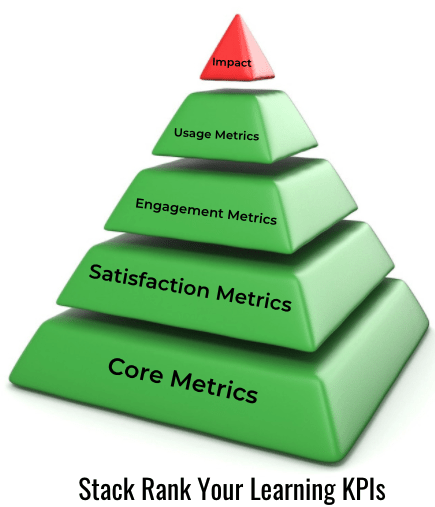Data has enormous potential to drive the success of customer education. It can tell you what’s working and what’s not. It can give you agility, leading you to the right levers to pull to continuously improve. It can show you the connections between outcomes and how it influences business goals. But… you need to be measuring the right things. You need to focus on the right Key Performance Indicators, or KPIs.
Stack rank your customer education KPIs
It’s most effective to look at, and measure customer education at different levels and to stack rank the critical KPIs. Let’s take a strategic look at each level. There will definitely be additional tactical levels of metrics within each.

Core Learning Metrics
These are very basic training metrics and are unlikely to vary much from client to client. How many of your accounts get trained. How many learners within each account get trained. It’s the bottom of the pyramid for a solid reason.
Satisfaction Metrics
Satisfaction can be quantitative and qualitative, simple to complex. One input are the smile sheets, and many organizations have relied on these for years. The other end of the spectrum are CSAT, NPS or qualitative surveys. They each provide measurable and anecdotal feedback from your customers.
Learning Engagement Metrics
The next level up is engagement KPIs. In formulating these KPIs you should look at areas including:
- How often and at what intervals do learners engage with our content?
- Do registrants show up?
- Do they finish?
- Are they opening and viewing our content?
- How many start certification and how many get certified? How long did it take?
Usage Metrics
One of your training goals is likely: to enable customers to understand and use your product successfully in their job, better than before. It is one job of these KPIs to show the relationship between training and usage and the difference between trained and untrained users. It is powerful to show your management, and your customer, that customer education definitely increases usage. It is putting your customer closer to achieving the impact KPIs.
Impact Metrics
These are the hardest to define and the data is the hardest to get. The point is to measure the impact of training. As we said earlier, the goal of training is likely to enable customers to understand and use your product successfully in their job, better than before. These KPIs show whether your customer education did or did not do its job, point by point. These KPIs are what the executive team wants to see.
Developing the customer education KPIs
The place to start the development process is at the top of the pyramid – define the specific impact or value that your customer desires, that they came to you for. To be sure, these impact KPIs will vary depending on the size and scope and complexity of the training. There is no magic metric. You’ve got to dig down.
When you approach a new training assignment, you need to understand what drove an organization to invest in customer education. What success looks like for them. What are their KPIs? Ideally, they will be specific on how they measure the improvements they need, such as user adoption and success, time to value, etc. Then, you can use this information to identify the waterfall of metrics that will lead you to the outcomes they desire.
One thing to bear in mind as you develop these impact KPIs is the need to show some quick wins. Early, measurable achievements build credibility and trust and that is a firm foundation for building the customer experience.
As you develop the KPIs, it is necessary to identify and categorize the behaviors that customer education needs to create. Product marketing and CSMs can help define what it takes to activate a user and analyzing support tickets can identify learning gaps. There’s no substitute for talking this through with your customer to understand the jobs, roles, cohorts and measurement of the learners, because that’s what ultimately boils up to impact, as the customer defines impact.
Sometimes you have the data, sometimes you don’t
Having defined the KPIs, now you have to identify the data that stands behind the KPIs. Sometimes your questions might be, “Here’s the data I need, where can I find it?” Often the question is, “What data do we have available?”
Bob is the head of training at a large, successful SaaS company. He came in shortly after inception and has basically built the department from the ground up. Here’s his perspective regarding finding the data:
“Turn over every rock, look everywhere, ask every question and then ask again. Data may be stored in a spreadsheet. Some, like trainer activity and surveys, may be on Google. Build the data landscape, write it all down.
“We did that at a previous company and eventually we had a ton of data. We found the best was to put it all on one platform. We used Salesforce and put in the training data, the survey data, customer data and ultimately all of our data sources. This gave us the ability to answer questions about the ROI of training and, that’s what eventually got our management to approve the new LMS.”
A careful, methodical, and collaborative approach to defining, measuring and using these KPIs has enabled us to do a much better job for our customers, and for our company.

An asset that may help you do a better job is our listicle, 5 Must-Have KPIs for Customer Education Success. It’s yours for the asking.



